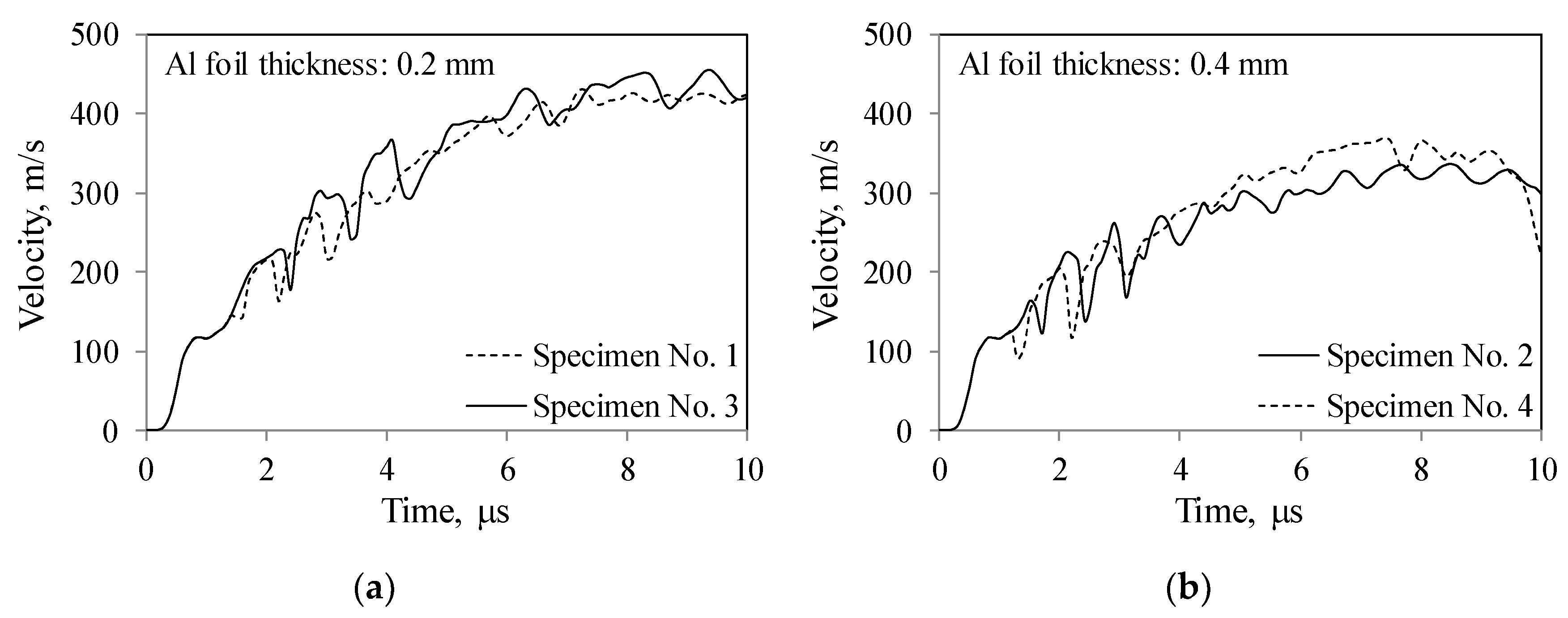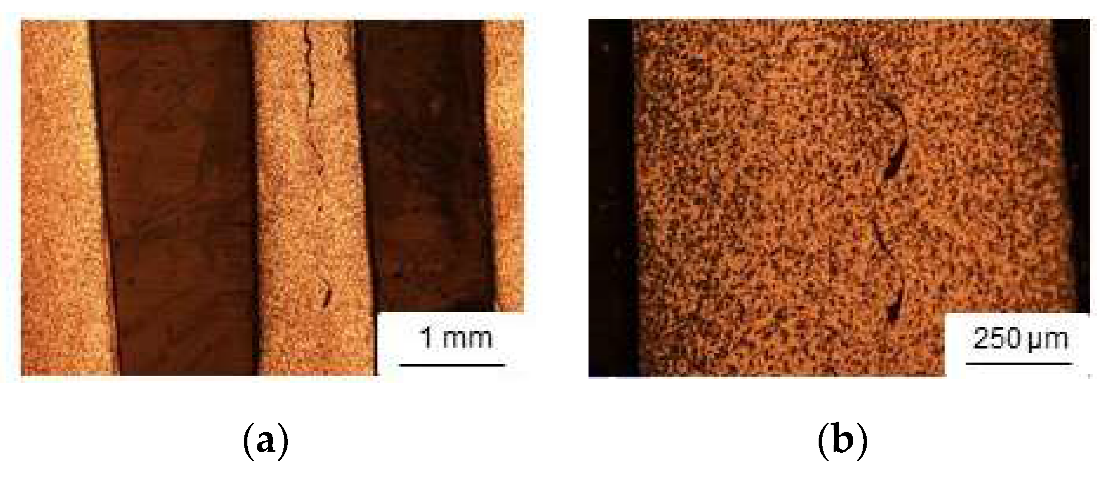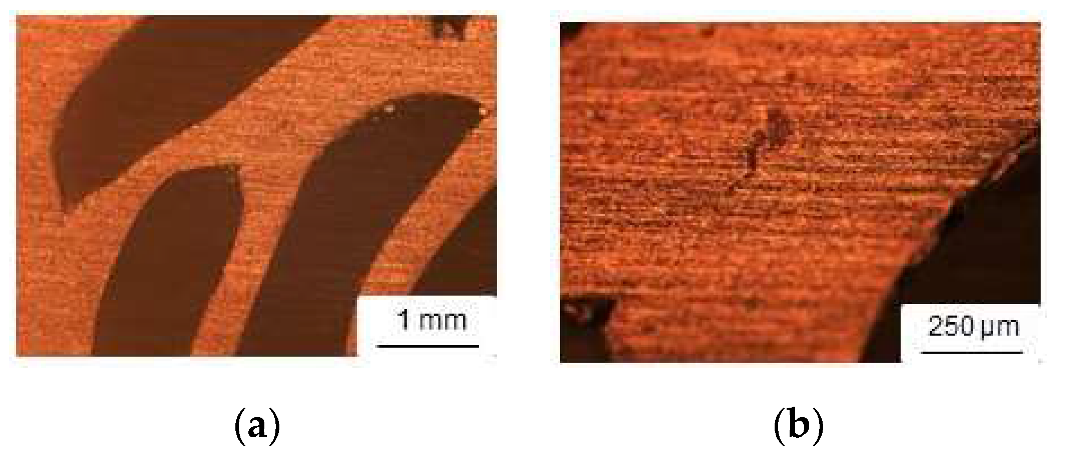Fabrication and Mechanical Properties of Rolled Aluminium Unidirectional Cellular Structure
Abstract
:1. Introduction
2. Fabrication Method and Specimens
3. Computational Analysis of the Fabrication Process
3.1. Computational Model
3.2. Computational Results
4. Metallographic Analysis
5. Compressive Experiments
5.1. Experimental Set-Up
5.2. Experimental Results
6. Conclusions
Author Contributions
Funding
Acknowledgments
Conflicts of Interest
References
- Lefebvre, L.P.; Banhart, J.; Dunand, D.C. Porous Metals and Metallic Foams: Current Status and Recent Developments. Adv. Eng. Mater. 2008, 10, 775–787. [Google Scholar] [CrossRef] [Green Version]
- Ashby, M.F.; Evans, A.; Fleck, N.A.; Gibson, L.J.; Hutchinson, J.W.; Wadley, H.N.G. Metal Foams: A Design Guide; Elsevier Science: Burlington, MA, USA, 2000. [Google Scholar]
- Matsumoto, R.; Kanatani, S.; Utsunomiya, H. Filling of surface pores of aluminum foam with polyamide by selective laser melting for improvement in mechanical properties. J. Mater. Process. Technol. 2016, 237, 402–408. [Google Scholar] [CrossRef]
- Duarte, I.; Vesenjak, M.; Krstulović-Opara, L.; Ren, Z. Crush performance of multifunctional hybrid foams based on an aluminium alloy open-cell foam skeleton. Polym. Test. 2018, 67, 246–256. [Google Scholar] [CrossRef]
- Banhart, J. Manufacture, characterisation and application of cellular metals and metal foams. Prog. Mater. Sci. 2001, 46, 559–632. [Google Scholar] [CrossRef]
- Lehmhus, D.; Vesenjak, M.; de Schampheleire, S.; Fiedler, T.; Schampheleire, S.; Fiedler, T. From Stochastic Foam to Designed Structure: Balancing Cost and Performance of Cellular Metals. Materials 2017, 10, 922. [Google Scholar] [CrossRef] [Green Version]
- Hohe, J.; Hardenacke, V.; Fascio, V.; Girard, Y.; Baumeister, J.; Stöbener, K.; Weise, J.; Lehmhus, D.; Pattofatto, S.; Zeng, H.; et al. Numerical and experimental design of graded cellular sandwich cores for multifunctional aerospace applications. Mater. Des. 2012, 39, 20–32. [Google Scholar] [CrossRef]
- García-Moreno, F. Commercial Applications of Metal Foams: Their Properties and Production. Materials 2016, 9, 85. [Google Scholar] [CrossRef] [PubMed]
- Zhang, L.; Tan, J.; Meng, Z.D.; He, Z.Y.; Zhang, Y.Q.; Jiang, Y.H.; Zhou, R. Low elastic modulus Ti-Ag/Ti radial gradient porous composite with high strength and large plasticity prepared by spark plasma sintering. Mater. Sci. Eng. A 2017, 688, 330–337. [Google Scholar] [CrossRef]
- Harih, G.; Borovinsek, M.; Ren, Z.; Dolsak, B. Optimal Products’ Hand-Handle Interface Parameter Identification. Int. J. Simul. Model. 2015, 14, 404–415. [Google Scholar] [CrossRef]
- Duarte, I.; Banhart, J. A study of aluminium foam formation—kinetics and microstructure. Acta Mater. 2000, 48, 2349–2362. [Google Scholar] [CrossRef]
- Öchsner, A.; Augustin, C. (Eds.) Multifunctional Metallic Hollow Sphere Structures; Springer: Berlin, Germany, 2009; ISBN 978-3-642-00490-2. [Google Scholar]
- Lee, Y.-H.; Lee, B.-K.; Jeon, I.; Kang, K.-J. Wire-woven bulk Kagome truss cores. Acta Mater. 2007, 55, 6084–6094. [Google Scholar] [CrossRef]
- Novak, N.; Vesenjak, M.; Ren, Z. Auxetic Cellular Materials-a Review. J. Mech. Eng. 2016, 62, 485–493. [Google Scholar] [CrossRef] [Green Version]
- Soro, N.; Attar, H.; Wu, X.; Dargusch, M.S. Investigation of the structure and mechanical properties of additively manufactured Ti-6Al-4V biomedical scaffolds designed with a Schwartz primitive unit-cell. Mater. Sci. Eng. A 2019, 745, 195–202. [Google Scholar] [CrossRef]
- Nakajima, H. Fabrication, properties and application of porous metals with directional pores. Prog. Mater. Sci. 2007, 52, 1091–1173. [Google Scholar] [CrossRef]
- Shapovalov, V.I. Porous metals. MRS Bull. 1994, 19, 24–29. [Google Scholar] [CrossRef]
- Hokamoto, K.; Vesenjak, M.; Ren, Z. Fabrication of cylindrical unidirectional porous metal with explosive compaction. Mater. Lett. 2014, 137, 323–327. [Google Scholar] [CrossRef]
- Movahedi, N.; Conway, S.; Belova, I.V.; Murch, G.E.; Fiedler, T. Influence of particle arrangement on the compression of functionally graded metal syntactic foams. Mater. Sci. Eng. A 2019, 764, 138242. [Google Scholar] [CrossRef]
- Katona, B.; Szlancsik, A.; Tábi, T.; Orbulov, I.N. Compressive characteristics and low frequency damping of aluminium matrix syntactic foams. Mater. Sci. Eng. A 2019, 739, 140–148. [Google Scholar] [CrossRef]
- Hokamoto, K.; Torii, S.; Kimura, A.; Kai, S. Metal Pipe Joint Body and Manufacturing Method Thereof. Japanese Patent 5848016, 4 December 2015. [Google Scholar]
- Vesenjak, M.; Hokamoto, K.; Anžel, I.; Sato, A.; Tsunoda, R.; Krstulović-Opara, L.; Ren, Z. Influence of the explosive treatment on the mechanical properties and microstructure of copper. Mater. Des. 2015, 75, 85–94. [Google Scholar] [CrossRef]
- Nishi, M.; Oshita, M.; Ulbin, M.; Vesenjak, M.; Ren, Z.; Hokamoto, K. Computational Analysis of the Explosive Compaction Fabrication Process of Cylindrical Uni-directional Porous Copper. Met. Mater. Int. 2018, 24, 1143–1148. [Google Scholar] [CrossRef]
- Hokamoto, K.; Shimomiya, K.; Nishi, M.; Krstulović-opara, L.; Vesenjak, M.; Ren, Z. Fabrication of unidirectional porous-structured aluminum through explosive compaction using cylindrical geometry. J. Mater. Process. Technol. 2018, 251, 262–266. [Google Scholar] [CrossRef]
- Vesenjak, M.; Hokamoto, K.; Sakamoto, M.; Nishi, T.; Krstulović-Opara, L.; Ren, Z. Mechanical and microstructural analysis of unidirectional porous (UniPore) copper. Mater. Des. 2016, 90. [Google Scholar] [CrossRef]
- Fiedler, T.; Borovinšek, M.; Hokamoto, K.; Vesenjak, M. High-performance thermal capacitors made by explosion forming. Int. J. Heat Mass Transf. 2015, 83, 366–371. [Google Scholar] [CrossRef]
- Vesenjak, M.; Hokamoto, K.; Matsumoto, S.; Marumo, Y.; Ren, Z. Unidirectional porous metal fabricated by rolling of copper sheet and explosive compaction. Mater. Lett. 2016, 170, 39–43. [Google Scholar] [CrossRef]
- Meyers, M.A.; Murr, L.E. Shock Waves and High-Strain-Rate Phenomena Effects in Metals; Springer: New York, NY, USA, 1981. [Google Scholar]
- Mayers, M.A. Dynamic Behavior of Materials; Wiley Interscience: New York, NY, USA, 1994. [Google Scholar]
- Marsh, S.P. Los Alamos Scientific Laboratory Report; LA-4167-MS; University of California Press: Oakland, CA, USA, 1969. [Google Scholar]
- Marsh, M.A. LASL Shock Hugoniot Data; University of California Press: Berkeley, CA, USA, 1980. [Google Scholar]
- Fujita, M.; Chiba, A.; Fukuda, I.; Osaka, H.; Baba, F.; Manabe, T. An analysis of multilayered explosive bonding process. Kyogyo-kayaku 1987, 48, 176–182. (In Japanese) [Google Scholar]
- Crossland, B. Explosive Welding of Metals and Its Application; Oxford University Press: Oxford, UK, 1982; Volume 8, p. 233. [Google Scholar]
- Krstulović-Opara, L.; Surjak, M.; Vesenjak, M.; Tonković, Z.; Kodvanj, J.; Domazet, Ž. Comparison of infrared and 3D digital image correlation techniques applied for mechanical testing of materials. Infrared Phys. Technol. 2015, 73, 166–174. [Google Scholar] [CrossRef]











| Specimen Type | Outer Pipe Diameter (mm) | Length (mm) | Internal Structure | Estimated Porosity (%) | |||
|---|---|---|---|---|---|---|---|
| Al Core Diameter (mm) | Al Foil Thickness (mm) | Acrylic Bar | |||||
| Thickness (mm) | Quantity (-) | ||||||
| No. 1 | 30/24 | 210 | 10 | 0.2 | 0.5 | 67 | 16.5 |
| No. 2 | 0.4 | 0.5 | 40 | 9.4 | |||
| No. 3 | 0.2 | 1.0 | 35 | 18.1 | |||
| No. 4 | 0.4 | 1.0 | 31 | 15.0 | |||
| Specimen Type | Number of Recovered Specimens (-) | Average Diameter (mm) | Average Height (mm) | Average Mass (g) | Achieved Average Porosity (%) |
|---|---|---|---|---|---|
| No. 1 | 4 | 26.2 | 11.0 | 12.8 | 15.5 |
| No. 2 | 4 | 26.2 | 11.9 | 14.9 | 9.3 |
| No. 3 | 1 | 26.3 | 10.4 | 12.7 | 17.5 |
| No. 4 | 4 | 26.0 | 10.4 | 12.3 | 15.0 |
| Material | Reference Density (kg/m3) | Gruneisen Coefficient (-) | Speed of Sound (m/s) | Material Constant (-) |
|---|---|---|---|---|
| A1100-O | 2707 | 1.9 | 5386 | 1.339 |
| Acrylic resin | 1186 | 0.97 | 2598 | 1.516 |
© 2020 by the authors. Licensee MDPI, Basel, Switzerland. This article is an open access article distributed under the terms and conditions of the Creative Commons Attribution (CC BY) license (http://creativecommons.org/licenses/by/4.0/).
Share and Cite
Vesenjak, M.; Nishi, M.; Nishi, T.; Marumo, Y.; Krstulović-Opara, L.; Ren, Z.; Hokamoto, K. Fabrication and Mechanical Properties of Rolled Aluminium Unidirectional Cellular Structure. Metals 2020, 10, 770. https://doi.org/10.3390/met10060770
Vesenjak M, Nishi M, Nishi T, Marumo Y, Krstulović-Opara L, Ren Z, Hokamoto K. Fabrication and Mechanical Properties of Rolled Aluminium Unidirectional Cellular Structure. Metals. 2020; 10(6):770. https://doi.org/10.3390/met10060770
Chicago/Turabian StyleVesenjak, Matej, Masatoshi Nishi, Toshiya Nishi, Yasuo Marumo, Lovre Krstulović-Opara, Zoran Ren, and Kazuyuki Hokamoto. 2020. "Fabrication and Mechanical Properties of Rolled Aluminium Unidirectional Cellular Structure" Metals 10, no. 6: 770. https://doi.org/10.3390/met10060770





